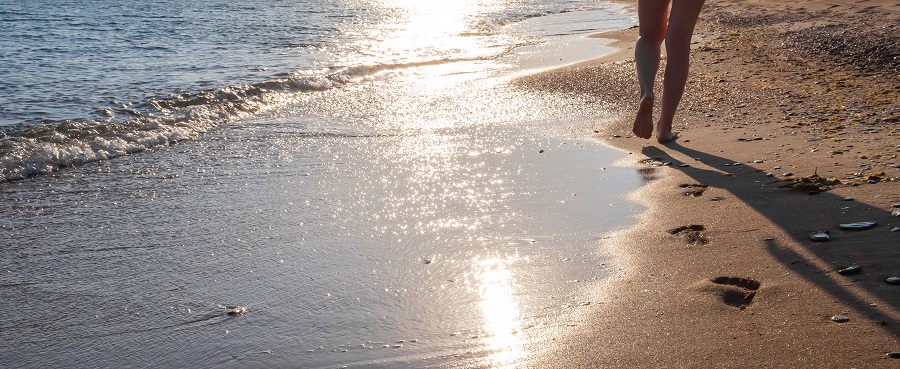Taking Fitness to the Beach - Walking on Sand

It’s widely known that walking is one of the best and easiest ways to add exercise to your life, but did you know that walking on sand can be easier on your body while giving you a better workout?
It’s widely known that walking is one of the best and easiest ways to add exercise to your life, but did you know that walking on sand can be easier on your body while giving you a better workout?
Walking on Sand - Easy on Your Body
The natural give of sand reduces the impact of your steps, making you less prone to injury while helping you build strength. Walking on sand — even hard-packed sand — is much easier on the body. It puts less stress on joints and is especially good for people prone to knee, back and hip pain.A Better Workout
While your body may thank you for the reduced impact of your beach stroll, it will also benefit from a good workout — one that’s possibly better than walking on a hard surface. It takes greater effort to walk on a soft surface like sand or grass. You can burn 20 to 50% more calories than walking on a firm surface. A 2020 study showed that walking on sand led to a more significant reduction in waist circumference than walking on pavement. The extra power it takes to propel yourself through the sand also strengthens muscles and tendons from your feet up to your back, especially those in your ankles, calves, quadriceps, and glutes.How to Get Started
Just like any exercise program, walking on sand is something to work on gradually. Here are some tips to safely start a beach walking routine.- Start on a solid surface: Warm up on pavement or a boardwalk to stretch muscles and warm up feet.
- Begin with hard-packed sand: In the preliminary stages of your new workout, spend more time on firmer sand, which helps train your muscles for softer sand.
- Take it easy: Walking long distances, especially on soft sand, can result in muscle and foot pain if you do too much too fast. Gradually add distance before transitioning part of your walk to soft sand. Build your endurance on soft sand over time.
- Footwear: Athletic shoes or sandals will support your feet and protect them from glass and other sharp objects. But you might want to save your best walking shoes for hard surfaces since some grains are bound to get into your shoes when walking on soft sand.
- Barefootin’: As you become more comfortable walking on sand, try walking short distances without your footwear to enjoy the feeling of sand between your toes. You may even want to get close to the water and let it wash over your feet. If you have diabetes, you'll want to keep your shoes on to avoid the risk of getting cuts.
- Adjust for the slope: There’s usually a gradual slope from the beach to the water. The foot closest to the ocean can be an inch or lower than the other. This difference can tire you and lead to strain if you're not careful. To avoid these issues, walk about a quarter of your planned distance, turn around, then repeat the process.
- Walk into the wind: Most days, there’s usually at least a little breeze on the beach; sometimes, the wind can be pretty strong. Walk into the wind at the beginning of your workout when you're most fresh. Allow the wind to give you a little push when you're more tired.
- Protect your skin: Don’t forget your hat, sunscreen, sunglasses, and lip balm, even on cloudy or foggy days.
- Stay hydrated: The sun, exertion and wind can cause dehydration more quickly than you might think. Bring a water bottle along, especially if you're walking for more than 30 minutes.
- Keep your eyes on the water: “Sneaker” waves can roll up suddenly, knock you off balance, or carry you out into the water. They can also wash debris onto the shore, which can hit you or cause trip hazards.

